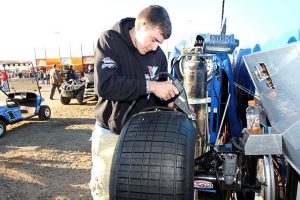Each sanctioning body will have a minimum suit rating required for competition. The standard for driving suits is 3.2A/X which is typically represented by a patch on the drivers’ left shoulder. The higher the SFI rating the higher the TPP value.
The SFI’s 3.2A spec (3.2A refers to suits specifically), in particular, is a test of a garment’s fire retardant capabilities, with a rating system put in place based on that item’s TPP (Thermal Protective Performance) when subjected to direct flame and radiant heat. This rating is designed to measure and correlate to the length of time one could be exposed to a heat source while wearing the garment before incurring second degree, skin-blistering burns. TPP is a product of exposure heat and exposure time, and is converted into a length of time before the second degree burns occur. The higher the number, the greater protection that a garment provides.
A common misconception is that the TPP ratings are the number of layers a garment has, but that is in fact not the case. Higher-rated garments do, however, generally contain more layers than a lower-rated one, as additional layers insulate and keep the heat source away from the skin by way of air gaps between the layers of fabric. An SFI 3.2A/15 and SFI 3.2A/20 suit are typically at least four or five layers, whereas an SFI 3.2A/5 is typically a two-layer suit.

 Grooving is exactly what it sounds like. You trim out a narrow strip of rubber from your tire to channel all the mud and dirt and debris to the outer edge, increasing your contact patch, and thus, your traction. There is most definitely an art to this, however. You can talk to five different people and get ten different patterns that they say are the best to groove into your tires. Horizontal, vertical, diagonal…heck you can even carve diamonds into the tread if it works for the particular track you are running at that point in time. Most
Grooving is exactly what it sounds like. You trim out a narrow strip of rubber from your tire to channel all the mud and dirt and debris to the outer edge, increasing your contact patch, and thus, your traction. There is most definitely an art to this, however. You can talk to five different people and get ten different patterns that they say are the best to groove into your tires. Horizontal, vertical, diagonal…heck you can even carve diamonds into the tread if it works for the particular track you are running at that point in time. Most 
